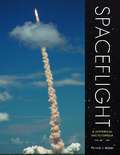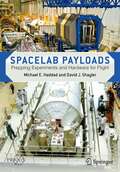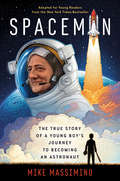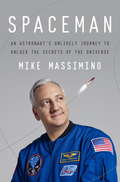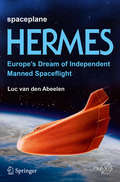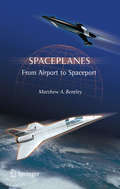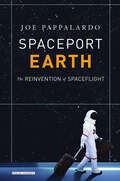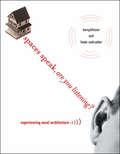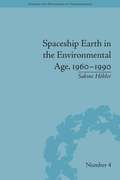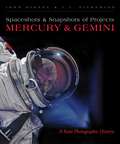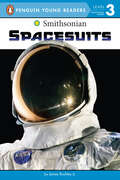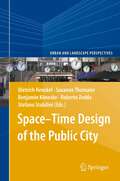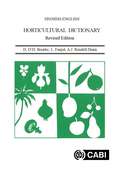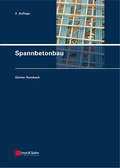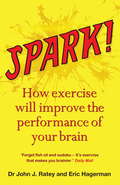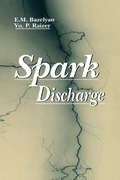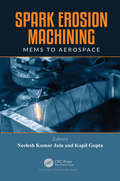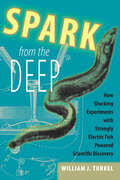- Table View
- List View
Spaceflight: A Historical Encyclopedia, Volume 2 (H-R)
by Patrick J. WalshThis book is a comprehensive history of the first six decades of space exploration, from the end of World War II to the modern era of routine international cooperation in space.
Spaceflight: A Historical Encyclopedia, Volume 3 (S-Z)
by Patrick J. WalshBeginning in the 1950s, spaceflight's history spans about a half a century--a short history, but profound in its cultural and technological impact and the level of resources involved. Evidently bound by love to the study, Walsh has assembled this three-volume reference, which includes entries on every space mission, both human and robotic, and is distinguished, also, by a substantial number of biographical entries covering astronauts, Russian cosmonauts, and other non-US, and non-Russian cosmonauts. Arranged alphabetically, the 699 entries are enhanced with small b&w photos; a chronology, a bibliography, and a comprehensive index appear in the third volume. Clear, accessible writing and comprehensive coverage make this a useful and engaging reference that will serve a wide audience of students and the general public as well as industry workers interested in the context and history of their endeavors. Annotation ©2010 Book News, Inc., Portland, OR (booknews.com)
Spacelab Payloads: Prepping Experiments and Hardware for Flight (Springer Praxis Books)
by David J. Shayler Michael E. HaddadSpacelab was a reusable laboratory facility that was flown on the Space Shuttle from 1983 to 1998. Completing 22 major missions and contributing to many other NASA goals, Spacelab stands as one of the Shuttle program’s most resounding successes. The system comprised multiple components, including a pressurized laboratory module, unpressurized carrier pallets and other related hardware, all housed in the Shuttle’s Payload Bay and crew compartment. But how did all those varied components actually come together? The answer is the little-known “Level-IV”, a team of managers and engineers who molded separate elements of hardware into cohesive and safe payloads. Without the dedication and drive of the Level-IV team, the huge successes of the Spacelab missions would not have been achieved. This is their story. You will learn herein how Level-IV was formed, who was involved, and the accomplishments, setbacks and problems faced along the way, in a story that blends both the professional and personal sides of Level-IV operations and its legacy. Upon reading this book, you will gain a new appreciation for this crucial team and understand what is meant when you hear the term “Level-IV”.
Spaceman (Adapted for Young Readers): The True Story of a Young Boy's Journey to Becoming an Astronaut
by Mike MassiminoAn astronaut who completed spacewalks on two Hubble missions tells his inspiring story in this middle grade adaptation of the bestselling adult memoir, Spaceman: An Astronaut's Unlikely Journey to Unlock the Secrets of the Universe.From the time he was seven-years-old and saw Apollo 11 land on the moon, Mike Massimino dreamed of becoming an astronaut. Long Island is a long way from space. Kids like him, growing up in working-class families, seldom left the neighborhood. But with the encouragement of teachers and mentors, Mike ventured down on a path that took him to Columbia University and to MIT. It wasn't easy. There were academic setbacks and disappointments aplenty--and NASA turned him down three times. Still, Mike never gave up. He rose to each challenge and forged ahead, inching closer to realizing his boyhood dream. His love of science and space, along with his indomitable spirit and sense of teamwork eventually got him assigned to two missions to fix the Hubble Space Telescope--as a spacewalker. Spaceman takes readers on Mike's unlikely ride from Earth to space, showing the breathtaking wonder of science and technology along the way."Mike Massimino is a spaceman through and through. In this edition for young people, he tells us how hard work can take you out of this world. He believes in teamwork, and he never gives up. Prepare to be inspired." --BILL NYE, SCIENCE GUY and CEO, THE PLANETARY SOCIETY
Spaceman: An Astronaut's Unlikely Journey to Unlock the Secrets of the Universe
by Mike MassiminoNEW YORK TIMES BESTSELLER • NASA astronaut Mike Massimino shares incredible true stories from space—a rare, wonderful world where science meets the most thrilling adventure. &“Mike is a spaceman through and through; he tells how hard work can take you out of this world.&”—Bill Nye the Science Guy Have you ever wondered what it would be like to find yourself strapped to a giant rocket that&’s about to go from zero to 17,500 miles per hour? Or to look back on Earth from outer space and see the surprisingly precise line between day and night? Or to stand in front of the Hubble Space Telescope, wondering if the emergency repair you&’re about to make will inadvertently ruin humankind&’s chance to unlock the universe&’s secrets? Mike Massimino has been there, and in Spaceman he puts you inside the suit, with all the zip and buoyancy of life in microgravity.Massimino&’s childhood space dreams were born the day Neil Armstrong set foot on the moon. Growing up in a working-class Long Island family, he catapulted himself to Columbia and then MIT, only to flunk his first doctoral exam and be rejected three times by NASA before making it through the final round of astronaut selection.Taking us through the surreal wonder and beauty of his first spacewalk, the tragedy of losing friends in the Columbia shuttle accident, and the development of his enduring love for the Hubble Telescope—which he and his fellow astronauts were tasked with saving on his final mission—Massimino has written an ode to never giving up, revealing just what having &“the right stuff&” really means.
Spaceplane HERMES
by Luc van den AbeelenThis is the first comprehensive book on the European Hermes program. It tells the fascinating story of how Europe aimed for an independent manned spaceflight capability which was to complement US and Soviet/Russian space activities. In 1975, France decided to expand its plans for automated satellites for materials processing to include the development of a small 10 ton spaceplane to be launched on top of a future heavy-lifting Ariane rocket. This Hermes spaceplane would give Europe its own human spaceflight capability for shuttling crews between Earth and space stations. The European Space Agency backed the proposal. Unfortunately, after detailed studies, the project was cancelled in 1993. If Hermes had been introduced into service, it could have become the preferred "space taxi" for ferrying crews to and from the International Space Station. But that opportunity was lost. This book provides the first look of the complete story of and reasons for the demise of this ambitious program. It also gives an account which pieces of Hermes survived and are active in the 2nd decade of the 21st century. This fascinating story will be a great read for space enthusiasts. But it will also serve as a comprehensive documentation of an important episode in the history of manned spaceflight.
Spaceplanes
by Matthew A. BentleySpaceplanes From Airport to Spaceport presents a coherent, lucid, and optimistic picture of the future of the near future. Space vehicles may soon take off from international airports and refuel in space. New technologies could allow flights to take off regularly between the Earth and the Moon. The technical details presented explain precisely how all this can be accomplished within the next few decades. This book also explains why the Space Tourist market could easily become the single most important factor in the mid-term future development of space transportation. In a few years it will be possible to board a spaceplane and fly into Earth orbit, and perhaps visit a space station. Later development could include refuelling in orbit to take a tour of cislunar space. The book's solid engineering foundation will be of interest to both space exploration enthusiasts and future space travelers.
Spaceport Earth: The Reinvention of Spaceflight
by Joe Pappalardo“Tackles the ever-changing, twenty-first-century space industry and what privately funded projects like Elon Musk’s SpaceX mean for the future of space travel.” —Foreign PolicyCreating a seismic shift in today’s space industry, private sector companies including Elon Musk’s SpaceX and Jeff Bezos’s Blue Origin are building a dizzying array of new spacecraft and rockets, not just for government use, but for any paying customer. At the heart of this space revolution are spaceports, the center and literal launching pads of spaceflight. Spaceports cost hundreds of millions of dollars, face extreme competition, and host operations that do not tolerate failures—which can often be fatal.Aerospace journalist Joe Pappalardo has witnessed space rocket launches around the world, from the jungle of French Guiana to the coastline of California. In his comprehensive work Spaceport Earth, Pappalardo describes the rise of private companies and how they are reshaping the way the world is using space for industry and science. Spaceport Earth is a travelogue through modern space history as it is being made, offering space enthusiasts, futurists, and technology buffs a close perspective of rockets and launch sites, and chronicling the stories of industrial titans, engineers, government officials, billionaires, schemers, and politicians who are redefining what it means for humans to be a spacefaring species.“Private companies and rich people like Elon Musk and Jeff Bezos have taken over the exploration of space. Pappalardo explores this new sort of spacefaring at the outer reaches of business and technology.” —The New York Times “For anyone obsessed with how spaceflight grew into what it is today, this book is a must-have.” —Popular Mechanics
Spaceports in Europe (Studies in Space Policy #34)
by Annette FroehlichThis book explores how Europe is seeking to enlarge its launching capacities by building additional spaceports on the European continent. Various national initiatives are envisaged resulting in a “space race” in the field of constructing spaceports and building micro launchers. However, right from the beginning when choosing the launch site (land or sea based-rocket launches) there are various factors relating to international space law, European regulations and national rules that must be considered, as spaceports are rarely explicitly addressed in current legal and policy frameworks. While launching sites used to be operated by governments, private commercial initiatives are increasingly entering the field. This paradigm shift must be reflected within regulations relating to various aspects of space liability by enlarging the long-established terms of the United Nations space treaties to accommodate commercial space flights. Questions of permission, supervision and control require special liability regulations to avoid detrimental consequences stemming from the concept of “launching states” in view of the rise of private driven commercial space activities on a global level. Furthermore, not only do environmental aspects need to be thoroughly examined but also the concept of critical infrastructure requires special attention from a security perspective to anticipate, inter alia, cyber-attacks. For these reasons, several European and national regulations may need to be enlarged to apply to the entire space sector, using a harmonized approach that has direct implications for the regulations, programmes, and missions of the European Union and the European Space Agency, bearing in mind that the upcoming spaceports in Europe are an essential asset to substantially boost the European New Space.
Spaces Speak, Are You Listening?: Experiencing Aural Architecture
by Barry Blesser Linda-Ruth SalterHow we experience space by listening: the concepts of aural architecture, with examples ranging from Gothic cathedrals to surround sound home theater. We experience spaces not only by seeing but also by listening. We can navigate a room in the dark, and "hear" the emptiness of a house without furniture. Our experience of music in a concert hall depends on whether we sit in the front row or under the balcony. The unique acoustics of religious spaces acquire symbolic meaning. Social relationships are strongly influenced by the way that space changes sound. In Spaces Speak, Are You Listening?, Barry Blesser and Linda-Ruth Salter examine auditory spatial awareness: experiencing space by attentive listening. Every environment has an aural architecture. The audible attributes of physical space have always contributed to the fabric of human culture, as demonstrated by prehistoric multimedia cave paintings, classical Greek open-air theaters, Gothic cathedrals, acoustic geography of French villages, modern music reproduction, and virtual spaces in home theaters. Auditory spatial awareness is a prism that reveals a culture's attitudes toward hearing and space. Some listeners can learn to "see" objects with their ears, but even without training, we can all hear spatial geometry such as an open door or low ceiling.Integrating contributions from a wide range of disciplines—including architecture, music, acoustics, evolution, anthropology, cognitive psychology, audio engineering, and many others—Spaces Speak, Are You Listening? establishes the concepts and language of aural architecture. These concepts provide an interdisciplinary guide for anyone interested in gaining a better understanding of how space enhances our well-being. Aural architecture is not the exclusive domain of specialists. Accidentally or intentionally, we all function as aural architects.
Spaces of Environmental Justice (Antipode Book Series #25)
by Ryan Holifield Michael Porter Gordon WalkerIn this cutting-edge volume, leading scholars examine a diverse range of environmental inequalities from around the world. Shows how far the field has moved beyond its original focus on uneven distributions of pollution in the USA Considers the influence of critical geographical and social theory on environmental justice studies Examines a range of possibilities for future research directions Explores the challenges of investigating and pursuing environmental justice at a time of rapid economic and environmental change
Spaceship Earth in the Environmental Age, 1960–1990 (History and Philosophy of Technoscience)
by Sabine HöhlerThe idea of the earth as a vessel in space came of age in an era shaped by space travel and the Cold War. Höhler’s study brings together technology, science and ecology to explore the way this latter-day ark was invoked by politicians, environmentalists, cultural historians, writers of science fiction and many others across three decades.
Spaceshots and Snapshots of Projects Mercury and Gemini: A Rare Photographic History
by John Bisney J. L. PickeringThe race to space between the United States and the Soviet Union captured the popular imagination. On April 12, 1961, the USSR launched cosmonaut Yuri Gagarin on a one-orbit flight, making him the first human in space. Three weeks later, American astronaut Alan B. Shepard Jr. flew 116 miles above Earth before splashing down in the Bahamas. Over the next twenty years astronauts emerged as national heroes.This book tells the story of the people and events of Projects Mercury and Gemini with hundreds of unpublished and rare photographs—both color and black-and-white. Unlike other publications, which illustrate the space race with well-known and easily accessible images, this history draws from the authors&’ private library of over one hundred thousand (and growing) high-quality photos of the early US manned space program. Collected over a lifetime from public and private sources—including NASA archives, fellow collectors, retired NASA and news photographers, and auction houses—the images document American space missions of the Cold War era more comprehensively than ever before. Devoting a chapter to each flight, the authors also include detailed descriptions, providing new insight into one of America&’s greatest triumphs.
Spacesuits (Smithsonian)
by James BuckleyWhat does an astronaut wear to work? Find out in this space-age Penguin-Smithsonian reader!If you're going to orbit the Earth, moonwalk, or float in space, you need the right outfit. From helmet to space boots, every part of an astronaut's spacesuit is designed for survival. This reader, developed with Smithsonian's popular Air and Space Museum, provides a close look at the suits, boots, helmets, gloves, and other gear astronauts have worn into space, from the early days of space exploration to the present-day.
Space–Time Design of the Public City
by Dietrich Henckel Benjamin Könecke Stefano Stabilini Roberto Zedda Susanne ThomaierTime has become an increasingly important topic in urban studies and urban planning. The spatial-temporal interplay is not only of relevance for the theory of urban development and urban politics, but also for urban planning and governance. The space-time approach focuses on the human being with its various habits and routines in the city. Understanding and taking those habits into account in urban planning and public policies offers a new way to improve the quality of life in our cities. Adapting the supply and accessibility of public spaces and services to the inhabitants' space-time needs calls for an integrated approach to the physical design of urban space and to the organization of cities. In the last two decades the body of practical and theoretical work on urban space-time topics has grown substantially. The book offers a state of the art overview of the theoretical reasoning, the development of new analytical tools, and practical experience of the space-time design of public cities in major European countries. The contributions were written by academics and practitioners from various fields exploring space-time research and planning.
Spain’s Photovoltaic Revolution: The Energy Return on Investment
by Charles A. Hall Pedro A. PrietoThe Energy Return on Energy Invested (EROI or EROEI) is the amount of energy acquired from a particular energy source divided by the energy expended, or invested, in obtaining that energy. EROI is an essential and seemingly simple measure of the usable energy or "energy profit" from the exploitation of an energy source, but it is not so easy to determine all of the energy expenditures that should be included in the calculation. Because EROI values are generally low for renewable energy sources, differences in these estimates can lead to sharply divergent conclusions about the viability of these energy technologies. This book presents the first complete energy analysis of a large-scale, real-world deployment of photovoltaic (PV) collection systems representing 3.5 GW of installed, grid-connected solar plants in Spain. The analysis includes all of the factors that limit and adjust the real electricity output through one full-year cycle, and all of the fossil fuel inputs required to achieve these results. The authors' comprehensive analysis of energy inputs, which assigns energy cost estimates to all financial expenditures, yields EROI values that are less than half of those claimed by other investigators and by the solar industry. Sensitivity analysis is used to test various assumptions in deriving these EROI estimates. The results imply that the EROI of current, large-scale PV systems may be too low to seamlessly support an energy and economic transition away from fossil fuels. Given the pervasiveness of fossil fuel subsidies in the modern economy, a key conclusion is that all components of the system that brings solar power to the consumer, from manufacturing to product maintenance and life cycle, must be improved in terms of energy efficiency. The materials science of solar conversion efficiency is only one such component. Sunny Spain represented an ideal case study as the country had the highest penetration of solar PV energy at 2.3 percent of total national demand as well as state-of-the-art expertise in solar power including grid management of intermittent, modern renewable systems. This book, written by a uniquely qualified author team consisting of the chief engineer for several major photovoltaic projects in Spain and the world's leading expert on the concept and application of EROI, provides a comprehensive understanding of the net energy available to society from energy sources in general and from functioning PV installations under real-world conditions in particular. The authors provide critical insight into the capacity of renewable energy sources to fill the foreseeable gap between world energy demand and depletion rates for fossil fuels. · Presents the first comprehensive study of the EROI of large-scale solar PV systems in a developed country · Uses real-world operational data rather than laboratory approximations and extrapolations · Describes the dependence of one alternative energy source on the goods and services of a fossil-fueled economy · Has global implications for the potential of renewable energy sources to replace dwindling reserves of fossil fuels · Written with the first-hand knowledge of the chief, on-site engineer for many solar installations in Spain together with the leader in the development and application of the concept of EROI
Spanish-English Horticultural Dictionary, Revised Edition
by D O'D Bourke Dr L Fanjul Dr Alexis J Rendell-DunnHorticulture is a significant industry in Spanish-speaking countries and countries with Spanish-speaking minority groups. This dictionary provides an authoritative source of horticultural terms in Spanish and their English equivalents. First published in 1987, it is compiled from a wide range of horticultural literature in the Spanish language, both temperate and tropical. Updated to include new terms, it covers technical terms, crop and pest names and related horticultural, agricultural, biological and botanical concepts. The dictionary includes temperate tree fruits and nuts, small fruits, viticulture, vegetables, ornamental plants, hops, industrial crops, and subtropical and tropical fruit and plantation crops. The names of diseases, pests and weeds of horticultural crops are included, accompanied by their scientific names. The genders of nouns are indicated throughout, as are feminine forms of adjectives and the plurals of certain words. Descriptions of plants are given where appropriate and English names where possible. It is essential for researchers, students and practitioners in horticulture in the various countries and regions where Spanish is spoken.
Spannbetonbau
by Günter RombachPrestressing increases the load-bearing capacity of reinforced concrete structures significantly and also improves their serviceability. Long span bridges, very slender stressed ribbon or large shell structures as well as tall liquid containers would not be possible without prestressing or at the very least very uneconomical. Aside from the traditional fields of application in bridge and precast construction, prestressing is increasingly being used in buildings and industrial structures. Thus, any structural engineer should possess sufficient know-how in prestressed concrete construction to which this book aims to contribute. This book comprehensively elucidates the design and construction of prestressed concrete structures and illustrates the various prestressing methods and systems. All the necessary background knowledge is provided for the design and construction of safe and durable prestressed concrete structures. The numerous innovations of the last few years in analysing and detailing prestressed concrete structures as well as in the prestressing systems themselves required an update from the first edition of this book. This edition also incorporates the recent changes in the codes DIN 1045-1 and DIN-Fachbericht 102 as well as suggestions from practical experience.
Spare Parts (Young Readers' Edition): The True Story of Four Undocumented Teenagers, One Ugly Robot, and an Impossible Dream
by Joshua DavisA riveting true story about dreams, dedication, and an amazing robot named Stinky, based on Joshua Davis' New York Times bestseller and now adapted for young readers by bestselling Mexican American author Reyna Grande. In 2004, four undocumented Mexican teenagers arrived at the national underwater robotics championship at the University of California, Santa Barbara. No one had ever told Oscar, Cristian, Luis, or Lorenzo that they would amount to much—until two inspiring high school science teachers convinced the boys to enter the competition. Up against some of the best collegiate engineers in the country, this team of underdogs from Phoenix, Arizona, scraped together spare parts and a few small donations to astound not only the competition's judges but themselves, too. Adapted by Reyna Grande—author of the acclaimed memoir The Distance Between Us about her experience as an undocumented child immigrant—this young readers’ edition of Joshua Davis’s New York Times bestseller showcases these students’ ingenuity and courage in the face of seemingly insurmountable odds. Timely and empowering, Spare Parts is an accessible introduction to STEM, immigration, and the reality of the American Dream.
Spare Parts: In Praise of Your Appendix and Other Unappreciated Organs
by Carol Ann RinzlerA tribute to the parts we can live without . . . or can we? This book sheds light on human body parts once considered extraneous but now with modern medicine and modern medical paraphernalia shown to play an important role in our healthful survival. With wit and research-honed wisdom, health writer Carol Ann Rinzler explains in layman's language why we need ?bonus” body parts such as: The appendix, once discarded as "the worm of the intestines,” but now believed to play an important role in our immune system The coccyx, a.k.a. the "tailbone,” once considered the remnant of a human tail, but now considered the keystone of the boney pelvic arch when muscles meet and stabilize our seating Wisdom teeth, that ?extra” set of molars for which many "evolved” human jaws lack accommodating space but still remain in place where we higher primates still follow a basic ?hard”diet that require extra chew power On the other hand, having highlighted the still-important parts, Rinzler adds a chapter on dispensables: parts with which we can indeed happily dispense. Along the way, Rinzler weaves in Darwin’s theories of evolution and shares insights on what the human body may be like millennia from now. Charles Darwin considered them extraneous, but this witty book sheds moderns scientific light on the Darwin Six —appendix, tailbone, third eyelid, wisdom teeth, external ear muscles, body hair—once considered useless, now known to be both valuable and interesting, plus a chapter on the true dispensables, parts with which we can indeed dispense. Along the way, best-selling author Rinzler weaves in Darwin's brilliant and ground-breaking theories of evolution and shares insights into what the human body may look like millennia from now.
Spark
by Eric Hagerman John Ratey Dr John J. Ratey Dr John RateyExercise is not only good for the body: it can transform your mind too. We all know that exercise is good for the body. But did you know that it can transform your mind? This new scientific revolution will teach you how to boost brain cells, protect yourself against mental illness and dementia, and ensure success in exams and the workplace. Follow the SPARK! training regimen and build your brain to its peak performance. This book will change the way you think about exercise - and, for that matter, the way you think.
Spark Discharge
by YuriP. RaizerSpark Discharge is a first-of-its-kind text, providing a comprehensive and systematic description of the spark breakdown of long gas gaps. It discusses the nature of a long spark, physical peculiarities of relevant gas discharge processes, methods and results of experimental studies, and analytical and numerical models. The most important applications in high-voltage engineering are covered in a single volume. The straightforward presentation of complicated materials, the deep insight into the nature of the processes, and the simplified mathematical descriptions of the phenomena, make Spark Discharge an excellent textbook for students and an indispensable reference for researchers, physicists, and engineers.
Spark Erosion Machining: MEMS to Aerospace
by Neelesh Kumar Jain; Kapil GuptaThis book bridges the gaps where limited resources are available on comprehensive coverage of spark erosion machining (SEM) based processes. It provides researchers and scholars a vast amount of information on recent research on the subject. It also serves as a resource of novel and specialized applications of spark erosion machining and its variants, for students and faculties involved with advanced machining processes. Some salient features of the book: Describes various important aspects of spark-erosion based processes including their derived and hybrid processes. Includes a broad scope of SEM applications from industrial, commercial, and scientific to aerospace, automobiles and biomedical domains. Covers a wide range of materials applications of SE-based processes to different exotic and difficult-to-machine materials, i.e. superalloys, composites, ceramics, shape memory alloys, etc. Provides details micro version of EDM and WEDM processes and their specialized applications.
Spark from the Deep: How Shocking Experiments with Strongly Electric Fish Powered Scientific Discovery (Animals History Culture)
by William J. TurkelHow encounters with strongly electric fish informed our grasp of electricity.Spark from the Deep tells the story of how human beings came to understand and use electricity by studying the evolved mechanisms of strongly electric fish. These animals can shock potential prey or would-be predators with high-powered electrical discharges.William J. Turkel asks completely fresh questions about the evolutionary, environmental, and historical aspects of people’s interest in electric fish. Stimulated by painful encounters with electric catfish, torpedos, and electric eels, people learned to harness the power of electric shock for medical therapies and eventually developed technologies to store, transmit, and control electricity. Now we look to these fish as an inspiration for engineering new sensors, computer interfaces, autonomous undersea robots, and energy-efficient batteries.Praise for Spark from the Deep“This beautifully written and exhaustively researched book traces the links between experiments on strongly electric fish and scientific understanding of electricity . . . Turkel’s book is a joy to read; it will entertain and educate scientists, historians, and anyone with an interest in the natural world.” —Choice“Turkel’s book convincingly reminds us that all the laptops and gadgets we surround ourselves with are remixes; altered versions of strongly electric fish. For that strange and insightful observation, this book ought to be widely read and enjoyed.” —Chris Conway, Endeavour“[I]t is refreshing to explore a book which takes seriously ancient encounters with manifestations of natural electricity as precursors to more recent innovations.” —James F. Stark, The British Journal for the History of Science
Spark from the Deep: How Shocking Experiments with Strongly Electric Fish Powered Scientific Discovery (Animals, History, Culture)
by William J. TurkelHow encounters with strongly electric fish informed our grasp of electricity.Spark from the Deep tells the story of how human beings came to understand and use electricity by studying the evolved mechanisms of strongly electric fish. These animals have the ability to shock potential prey or would-be predators with high-powered electrical discharges.William J. Turkel asks completely fresh questions about the evolutionary, environmental, and historical aspects of people’s interest in electric fish. Stimulated by painful encounters with electric catfish, torpedos, and electric eels, people learned to harness the power of electric shock for medical therapies and eventually developed technologies to store, transmit, and control electricity. Now we look to these fish as an inspiration for engineering new sensors, computer interfaces, autonomous undersea robots, and energy-efficient batteries.
